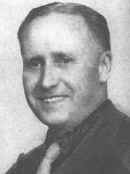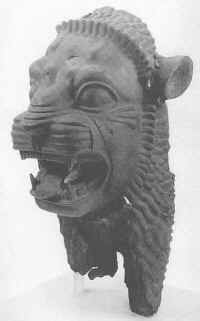 Between
1929-1933 Lieut-Colonel the Hon. M.T. Boscawen made
three visits to Hadhramaut (then part of Britain’s
Aden Protectorate) from his home near Tanga, East
Africa. In 1934 he visited Soqotra and in 1935 travelled
from Aden to Sana’a. He was the first European to
visit Tarim (1929) since Leo Hirsch in 1893, the first
to come within sight of Shabwa (1932), and the first to
visit Sei’ar country and to see and photograph the
South Arabian oryx (1933). He made a significant
contribution to the Natural History Museum’s
collection of birds from South Arabia, and it is through
him that the Fitzwilliam Museum in Cambridge came to
acquire one of the most important and striking exhibits
in its collection of antiquities — a first millennium
B.C. bronze ‘roaring’ lion (55.6 cm. high) found in
al-Qatn, Wadi Hadhramaut.
Between
1929-1933 Lieut-Colonel the Hon. M.T. Boscawen made
three visits to Hadhramaut (then part of Britain’s
Aden Protectorate) from his home near Tanga, East
Africa. In 1934 he visited Soqotra and in 1935 travelled
from Aden to Sana’a. He was the first European to
visit Tarim (1929) since Leo Hirsch in 1893, the first
to come within sight of Shabwa (1932), and the first to
visit Sei’ar country and to see and photograph the
South Arabian oryx (1933). He made a significant
contribution to the Natural History Museum’s
collection of birds from South Arabia, and it is through
him that the Fitzwilliam Museum in Cambridge came to
acquire one of the most important and striking exhibits
in its collection of antiquities — a first millennium
B.C. bronze ‘roaring’ lion (55.6 cm. high) found in
al-Qatn, Wadi Hadhramaut.
Boscawen made no record of his journeys in an area
which was then little known and largely unexplored,
despite being urged to do so by the few who knew enough
of these journeys to appreciate their importance. We
have brief glimpses of Boscawen in the travel literature
of the period (Van der Meulen, Freya Stark, Philby), but
it fell to Harold Ingrains, who met him in Aden in 1933
and 1935, to reconstruct his routes mainly from the
places where he had collected birds (places which
Boscawen had identified for the Natural History Museum)
and from the anecdotal evidence of local Hadhramis.
Following his initial visit to Shibam and Tarim in
1929, Boscawen returned to Hadhramaut in January 1932,
travelling via Mukalla and Shihr through Hamumi country
to Tarim. In February he travelled east down Wadi Masila
as far as Qabr Hud and then up Wadi Barhut to Bir
Barhut, previously visited by Van Der Meulen and Von
Wissman in 1930. Returning to Tarim he proceeded west to
Seiyun and Shibam where he arrived at the beginning of
March. From Shibam he started his return journey to Aden
and accompanied by an escort of Hamami bedouin, he
continued west through Wadi Dulir towards Shabwa. He
camped outside Shabwa but was fired on by local Buraiki
nomads and did not enter the village. He then visited
Wadi ‘Irma before turning south west to Nisab.
Travelling through Aulaqi and Audhali country he arrived
at Shuqra on the coast and was back in Aden the
following day. In February 1933 he returned again to
Hadhramaut and, travelling from the coast via Raidat
al-Johiyeen, he reached Shibam towards the end of March.
He left for the northern desert in April, proceeding via
Wadi Sirr (last visited by Theodore and Mabel Bent in
1897) to Husn Bin Rumaidan, the seat of one of the
principal leaders of the Sei’ar tribe. From there he
travelled through Wadi ‘Eiwa to the desert where he
spent a week tracking oryx with the Sei’ar. By May he
had returned to Mukalla and was back in Aden by early
June.
In his book Arabia and the Isles (1942),
Ingrams mentions that he asked Boscawen why he never
wrote anything down, and that Boscawen [a graduate of
Trinity College, Cambridge] replied, ‘I can’t
spell’! Perhaps a more compelling explanation lies in
Boscawen’s instinctive modesty and his aversion to any
form of self-publicity. Writing to the President of the
Royal Geographical Society, Admiral Sir William
Goodenough, in September 1933, in reply to the
latter’s request for a photographic portrait of him,
Boscawen said, ‘I am quite out of place among your
distinguished explorers etc ...’
Mildmay Thomas (Tommy) Boscawen (1892-1956) was a
younger son of the 7th Viscount Falmouth. He served with
the Rifle Brigade in the front line throughout the
1914-18 War, rising from subaltern to battalion
commander, and winning an MC at Loos in 1915 and a DSO
on the Somme in 1916. In a chapter on leadership in his
book, The Anatomy of Courage (1945), Lord Moran
(Winston Churchill’s doctor) wrote: ‘alone in its
influence over the hearts of men I place phlegm — a
supreme imperturbability in the face of death which half
amused them and half dominated them — the ultimate
gift in war. During an attack on Guillemont in the
Battle of the Somme an officer of the Rifle Brigade was
crossing the open [ground] under heavy shell fire when
he dropped his glove. He walked back two or three yards,
picked it up and went on.’
That officer was ‘Tommy’ Boscawen. After the war
he went out to Tanganyika (Tanzania) and built up what
was to become the largest individual sisal growing
enterprise in East Africa, covering some 85,000 acres.
There he employed an increasing number ofYemeni/Hadhrami
expatriates including one who became his trusted
assistant and travelling companion — Shaikh Abdullah
Abubakr al‘Amoodi, a native of Wadi Du’an in
Hadhramaut. Abdullah accompanied Boscawen on his trek
from India via Tibet to Chinese Turkestan in the 1920s;
and it was Abdullah who aroused Boscawen’s interest in
Hadhramaut and accompanied him on each of his three
journeys there; Abdullah returned to Du’an in 1934,
when Boscawen was on leave in England, and shot 37 birds
to add to the 127 skins which Boscawen had collected for
the Natural History Museum in 1932 and 1933.
Freya Stark and others have commented on the warmth
with which Boscawen was remembered in Hadhramaut — for
his personal charm and open-handedness (he paid
handsomely, for example, for the services of his bedouin
guides). He established a close relationship with Sultan
Ali bin Salah Al-Qu’aiti, a senior member of the
ruling Qu’aiti dynasty, who lived in al-Qatn. As Freya
Stark records somewhat wistfully, Sultan Ali presented
Boscawen with the magnificent first millennium B.C.
bronze ‘roaring’ lion (Fig. 1), which is now in the
Fitzwilliam Museum, Cambridge.
 |
| Fig. 1. Roaring Lion,
originally flanking a monumental entrance way,
8th-7th century BC. From al-Qatn, Wadi
Hadhramaut. Fitzwilliam Museum. |
When Boscawen first saw it, the bronze was lying on
its side in sand on the floor of a house some miles from
Shibam. Boscawen was reluctant to accept it but Sultan
Ali insisted. When he got it back to England the British
Museum showed not the slightest interest, so he took it
to Spinks for evaluation. There it was spotted by the
celebrated art dealer Lord Duveen, who offered Boscawen
£5,000 for it — a huge sum in the 1930s — but
Boscawen said that the bronze had been a gift to him and
was not for sale. Sultan Ali was also instrumental in
obtaining a live oryx for Boscawen to send to the London
Zoo — the first brought to England since 1878 (when a
specimen obtained in Jedda was sent but died soon
afterwards). Boscawen’s oryx is said to have been
walked from the desert down to Shibam on a lead behind a
camel, and then flown to Aden in an RAF ‘Wapiti’.
The photograph at Fig. 2 was taken shortly after the
animal’s arrival at the zoo in mid-1933, by
Boscawen’s ten year old nephew the Hon. Robert
Boscawen, using a Kodak Box Brownie camera! Oddly, there
is no mention of Boscawen’s gift to the zoo in Douglas
Carruthers’ Arabian Adventure (1935) which
published a photograph of the oryx which Boscawen had
tracked and shot in April 1933, nor in Anthony
Shepherd’s Flight of the Unicorns (1965) —
about the oryx expedition to Hadhramaut in 1962
sponsored by the Flora and Fauna Preservation Society
— which includes a detailed account of previous
European attempts to track or obtain a specimen.
 |
| Fig. 2. London Zoo,
1933. Courtesy: The Hon. Robert Boscawen,
MC |
Boscawen, in his turn, presented Sultan Ali with a
hunting rifle. This was inherited by the latter’s
younger son, Abdulaziz, and remained in his possession
until it was looted during the civil war of 1994. The
photograph at Fig. 3, taken by Boscawen in 1929, shows
Sultan Ali (1898-1948) with his elder son; sitting on
Sultan Ali’s left is Shaikh Hussain La’jam at whose
house just outside Shibam Boscawen used to stay. This
and Boscawen’s other photographs of Hadhramaut are
held in the Royal Geographical Society’s Picture
Library.
 |
| Fig. 3. Sultan Ali bin
Salah al-Qu’aiti, al-Qatn, 1929. The
Royal Ceographical Society |
Yemenis who knew Boscawen in East Africa remember him
for his open, unassuming nature and his philanthropy —
qualities which were seen as unusual in European
settlers at that time. Boscawen took a close interest in
the welfare of his staff, especially his Arab employees,
and in a number of cases financed at his own expense the
further education of their children. He built a mosque
at Moa for the local Muslim community in 1952, and would
make a point of attending the annual Muslim feast
commemorating the Prophet’s Birthday. In 1954 he made
a substantial contribution to the Arab Welfare
Association in Mombasa. Boscawen is also remembered for
his enjoyment of hunting and fishing (he went annually
to New Zealand to fish), his love of books and music,
but especially for his keen interest in agriculture;
much of his time was spent managing and touring,
sometimes by plane, his large sisal estates in Kenya
(Mwatate, near Voi) and Tanganyika (Moa and Tanga Line).
Due largely to his own reticence, our knowledge of
this intrepid traveller and enlightened planter will
always remain fragmentary; but his name lives on in the
Fitzwilliam Museum. During the last two decades of his
life Boscawen formed an impressive collection of
renaissance and later European sculptures, principally
bronzes, and from 1946 onwards lent anonymously to the
Museum a number of objects, including the bronze lion
given to him by Sultan Aui. After his death in 1956, the
collection passed to his sister the Hon. Pamela Sherek,
who in 1979 donated to the Museum, in her brother’s
memory, the objects already on loan. The Fitzwilliam
Museum acquired the remaining sculptures by bequest
following her death in 1995, and these form part of what
is now known as ‘The Boscawen Collection’.
I am most grateful to Viscount Falmouth and to the
Hon. Robert Boscawen for their personal recollections of
Colonel Boscawen (their uncle), and to both Mr Muhammad
al-Qa’tabi (grandson of Shaikh Abdullah Abubakr
al-’Amoodi) and Mr Sa’ud Abdullah al-Audhali for
their recollections of him in East Africa. I must also
record my warm appreciation of the help received from Mr
Muhammad Bin Dohry, the late Mr Abdullah Yumain Bin
Daghar, Mr Ralph Daly, Miss Leila Ingrams, Dr Abdulaziz
bin Aui Au-Qu’aiti, Dr Eleni Vassilika, Keeper of the
Department of Antiquities at the Fitzwilliam Museum, and
Christine Auder, Assistant Librarian, BirdLife
International, Cambridge.
